|
Strain Name
|
C57BL/6N-Cxcl13tm1(CXCL13)Bcgen/Cxcr5tm1(CXCR5)Bcgen/Bcgen
|
Common Name
|
B-hCXCL13/hCXCR5 mice
|
|
Background
|
C57BL/6N
|
Catalog number
|
111189
|
|
Aliases
|
CXCL13:BLC, BCA1, ANGIE, BCA-1, BLR1L, ANGIE2, SCYB13
CXCR5:BLR1, CD185, MDR15
|
mRNA expression analysis
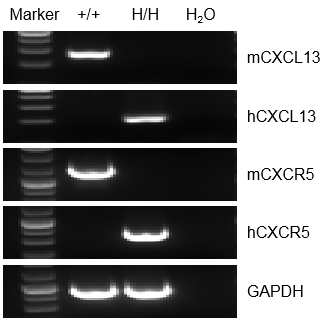
Strain specific analysis of CXCL13 and CXCR5 gene expression in WT and homozygous B-hCXCL13/hCXCR5 mice by RT-PCR. Mouse Cxcl13 and Cxcr5 mRNA were detectable in splenocytes of wild-type (+/+) mice. Human CXCL13 and CXCR5 mRNA were detectable only in homozygous B-hCXCL13/hCXCR5 mice , but not in wild-type (+/+) mice.
Protein expression analysis
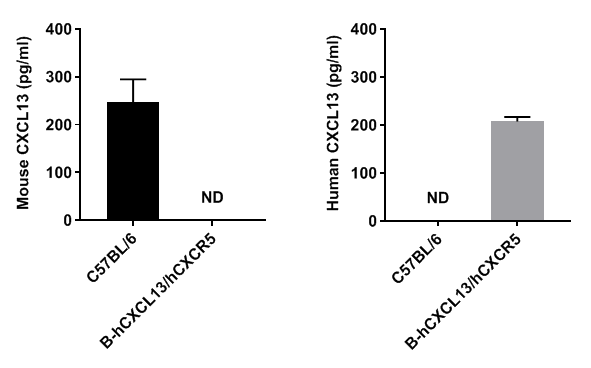
Strain specific CXCL13 expression analysis in homozygous B-hCXCL13/hCXCR5 mice by ELISA. Serum were collected from WT and homozygous B-hCXCL13/hCXCR5 mice, and analyzed by ELISA with species-specific CXCL13 ELISA kit. Mouse CXCL13 was detectable in WT mice. Human CXCL13 was exclusively detectable in homozygous B-hCXCL13/hCXCR5 but not WT mice.
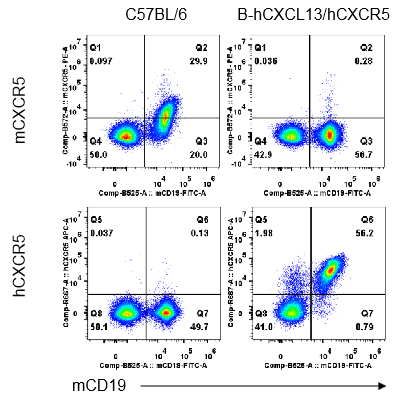
Strain specific CXCR5 expression analysis in homozygous B-hCXCL13/hCXCR5 mice by flow cytometry. Splenocytes were collected from WT and heterozygous B-hCXCL13/hCXCR5 mice, and analyzed by flow cytometry with species-specific CXCR5 antibody. Mouse CXCR5 was detectable in WT mice. Human CXCR5 was exclusively detectable in homozygous B-hCXCL13/hCXCR5 but not WT mice.
Analysis of leukocytes cell subpopulation in spleen

Analysis of spleen leukocyte subpopulations by FACS. Splenocytes were collected from WT and homozygous B-hCXCL13/hCXCR5 mice (n=3, 6-week-old). Flow cytometry analysis of the splenocytes was performed to assess leukocyte subpopulations. A. Representative FACS plots. Single live cells were gated for the CD45+ population and used for further analysis as indicated here. B. Results of FACS analysis. Percent of T cells, B cells, NK cells, dendritic cells, neutrophils, monocytes and macrophages in homozygous B-hCXCL13/hCXCR5 mice were similar to those in the C57BL/6 mice, demonstrating that introduction of hCXCL13/hCXCR5 in place of its mouse counterpart does not change the overall development, differentiation or distribution of these cell types in spleen. Values are expressed as mean ± SEM.
Analysis of T cell subpopulation in spleen
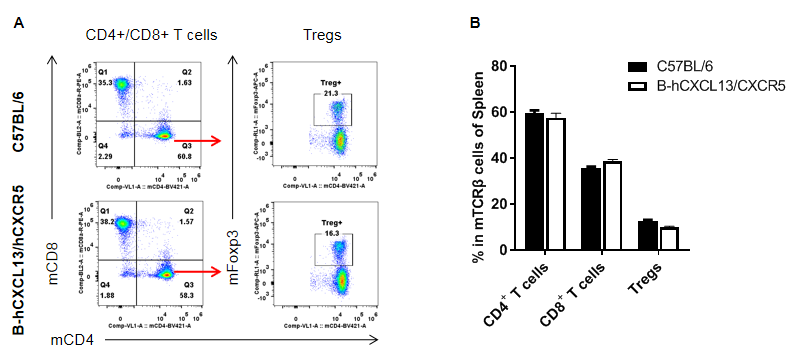
Analysis of spleen T cell subpopulations by FACS. Splenocytes were isolated from female C57BL/6 and homozygous B-hCXCL13/hCXCR5 mice (n=3, 6-week-old). Flow cytometry analysis of the splenocytes was performed to assess leukocyte subpopulations. A. Representative FACS plots. Single live CD45+ cells were gated for CD3+ T cell population and used for further analysis as indicated here. B. Results of FACS analysis. The percent of CD8+ T cells, CD4+ T cells, and Tregs in homozygous B-hCXCL13/hCXCR5 mice were similar to those in the C57BL/6 mice, demonstrating that introduction of hCXCL13/hCXCR5 in place of its mouse counterpart does not change the overall development, differentiation or distribution of these T cell subtypes in spleen. Values are expressed as mean ± SEM.
Analysis of leukocytes cell subpopulation in lymph node
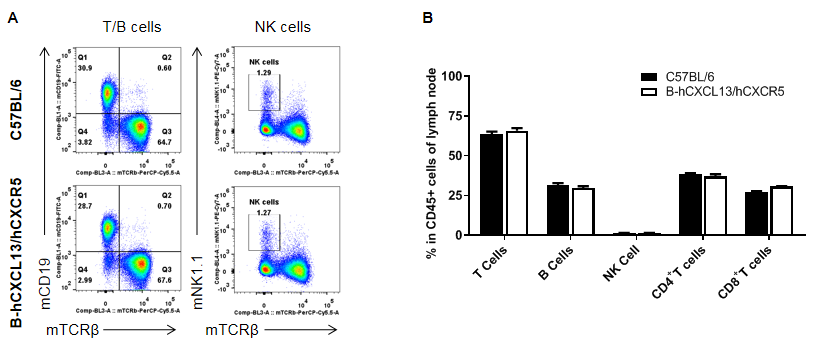
Analysis of lymph node leukocyte subpopulations by FACS. Leukocytes were collected from WT and homozygous B-hCXCL13/hCXCR5 mice (n=3, 6-week-old). Flow cytometry analysis of the splenocytes was performed to assess leukocyte subpopulations. A. Representative FACS plots. Single live cells were gated for the CD45+ population and used for further analysis as indicated here. B. Results of FACS analysis. The percent of T cells, B cells and NK cells in homozygous B-hCXCL13/hCXCR5 mice were similar to those in the C57BL/6 mice, demonstrating that introduction of hCXCL13/hCXCR5 in place of its mouse counterpart does not change the overall development, differentiation or distribution of these cell types in lymph node. Values are expressed as mean ± SEM.
Analysis of T cell subpopulation in lymph node
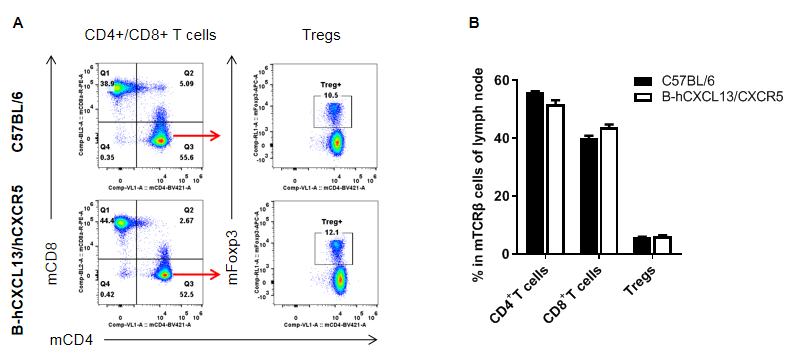
Analysis of lymph node T cell subpopulations by FACS. Leukocytes were isolated from female C57BL/6 and homozygous B-hCXCL13/hCXCR5 mice (n=3, 6-week-old). Flow cytometry analysis of the splenocytes was performed to assess leukocyte subpopulations. A. Representative FACS plots. Single live CD45+ cells were gated for CD3+ T cell population and used for further analysis as indicated here. B. Results of FACS analysis. The percent of CD8+ T cells, CD4+ T cells, and Tregs in homozygous B-hCXCL13/hCXCR5 mice were similar to those in the C57BL/6 mice, demonstrating that introduction of hCXCL13/hCXCR5 in place of its mouse counterpart does not change the overall development, differentiation or distribution of these T cell subtypes in lymph node. Values are expressed as mean ± SEM.
Analysis of leukocytes cell subpopulation in blood

Analysis of blood leukocyte subpopulations by FACS. Blood were collected from WT and homozygous B-hCXCL13/hCXCR5 mice (n=3, 6-week-old). Flow cytometry analysis of the splenocytes was performed to assess leukocyte subpopulations. A. Representative FACS plots. Single live cells were gated for the CD45+ population and used for further analysis as indicated here. B. Results of FACS analysis. Percent of T cells, B cells, NK cells, dendritic cells, neutrophils, monocytes and macrophages in homozygous B-hCXCL13/hCXCR5 mice were similar to those in the C57BL/6 mice, demonstrating that introduction of hCXCL13/hCXCR5 in place of its mouse counterpart does not change the overall development, differentiation or distribution of these cell types in blood. Values are expressed as mean ± SEM.
Analysis of T cell subpopulation in blood
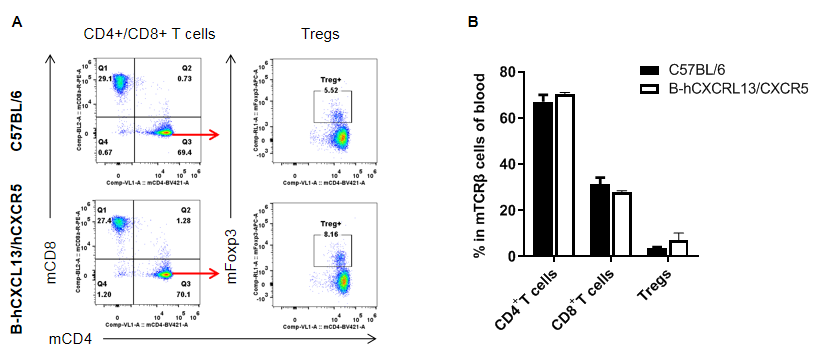
Analysis of blood T cell subpopulations by FACS. Blood were isolated from female C57BL/6 and homozygous B-hCXCL13/hCXCR5 mice (n=3, 6-week-old). Flow cytometry analysis of the splenocytes was performed to assess leukocyte subpopulations. A. Representative FACS plots. Single live CD45+ cells were gated for CD3+ T cell population and used for further analysis as indicated here. B. Results of FACS analysis. The percent of CD8+ T cells, CD4+ T cells, and Tregs in homozygous B-hCXCL13/hCXCR5 mice were similar to those in the C57BL/6 mice, demonstrating that introduction of hCXCL13/hCXCR5 in place of its mouse counterpart does not change the overall development, differentiation or distribution of these T cell subtypes in blood. Values are expressed as mean ± SEM.


















